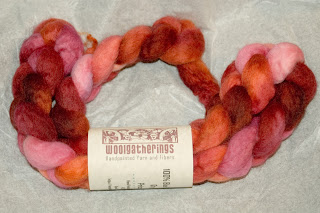This past Christmas I used some of my gift money to do something I haven't allowed myself to do in many years. I bought some wool for spinning that had been dyed by someone else! I bought this
Bluefaced Leicester top from
Woolgatherings.
I haven't bought spinning fiber (or yarn) in a very long time because I still have a ton of wool that I bought when I was working full time. I had stopped spinning and knitting for a while (see
this post), but in recent months I have been able to get back to it, as I have with my knitting. On the plus side, I'm not likely to run out of wool any time soon, and have enough for many pairs of toasty wool socks. The down side is that almost all of it was purchased as
raw fleece, and while it was washed ages ago when I bought it, it still needs to be carded before I can spin it.
Unfortunately I have found that while I love the look and smell of a (fresh and well-skirted!) raw fleece, I am bored to tears by the carding/combing process. This makes it difficult to spontaneously decide "I feel like spinning tonight!" I need to spend several days carding the wool before I have enough to spin, and if I'm tired and don't feel like breaking out the carding equipment, it doesn't get done. I've debated selling off the drum carder, but then I remember that there are some
breeds of sheep that can only be acquired as unprocessed fleece. My compromise is that in the future I'll only buy a raw fleece if it's something special I can't get commercially prepared.
As with the rest of the world, fashions come and go within various crafts. When I had been more actively involved, the "in" thing to do with multicolored tops like the one pictured was to
Navajo-ply it to preserve the appearance of the color repeats. This was also about the time when self-patterning "fair isle" yarns were being introduced, and people thought the idea of yarns that made stripes without having to weave in extra ends was kind of cool.
Current spinning fashion is shifting towards more subtle color changes. In the Summer 2007 issue,
Spin-Off magazine published an article on a technique the author called "fractal spinning." With this technique you split the spinning fiber lengthwise into strips of varied thickness, with the thicker sections providing longer color repeats than the thinner ones. When the resultant singles are plied together you end up with the longer color repeats acting as a sort of unifying background to the shorter color repeats, with the net effect being that the transitions between color changes in the finished piece are much softer. This was my first opportunity to try this technique.
I decided that I wanted a 3-ply fingering-weight yarn for socks. I split the tops into thirds, with one third left whole, and the other two split into two and three parts. You can see the difference the splitting makes in the singles!
Here's the yarn I ended up with - a lovely, drapey light-fingering-weight 3-ply.
I chose to knit a pair of
Kai-Mei socks from
Cookie A.'s book
Sock Innovation: Knitting Techniques & Patterns for One-of-a-Kind Socks
. These were a breeze compared to most of her other sock patterns! They only took me about a week and a half (not counting days I couldn't get any knitting done), and they are very warm and comfy!
As you can see, while there are definitely stripes, they have much softer edges than they would if the color transitions had been more abrupt. I may still have projects that want defined stripes, but it's nice to be able to choose a middle ground.




















